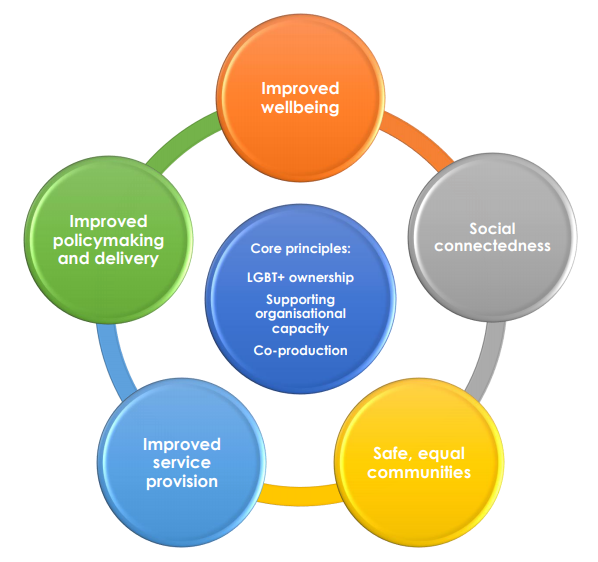Warning: Attempt to read property "roles" on bool in /srv/users/consortium/apps/consortium/public/wp-content/plugins/wp-user-frontend/wpuf-functions.php on line 4685
A Common Outcomes Framework for the LGBT+ Sector.
This Framework has been produced in collaboration with a range of LGBT+ groups. It seeks to act as an initial reference point for organisations to critically reflect on what outcomes they are best placed to achieve and potential areas of collaboration with others.
In creating this Framework, Consortium aims to help LGBT+ voluntary and community sector organisations identify the difference that their everyday activities have on the people and communities they work with.
In combination with a draft reference list of suggested outcomes measures, the Framework also seeks to act as a tool to help organisations of all sizes demonstrate that they are working towards the most pressing priorities for LGBT+ people in the UK.
The framework sets out a standardised structure of five core areas of impact and associated sub-outcomes, as well as three underlying principles.

Find out more about each of the outcome areas
Why is this important?
The LGBT+ voluntary and community sector is extremely diverse, composed of a wide range of organisations that vary significantly in size, form and focus.
All of these organisations face significant service pressures in the wake of public/statutory funding reductions for their services, and increased demand as general provision and support has also been reduced for LGBT+ people.
Within this context, organisations face increased competition for resources and more limited opportunities for collaboration. Organisations also have limited resources to direct towards monitoring, evaluation and learning, creating an evidence gap around the achievements of the LGBT+ sector in the UK.
This framework seeks to act as an initial reference point for organisations to critically reflect on what outcomes they are best placed to achieve and potential areas of collaboration with others. In combination with a draft reference list of suggested outcomes measures, it also seeks to act as a tool to help organisations of all sizes demonstrate that they are working towards the most pressing priorities for LGBT+ people in the UK.
How has this been produced?
The framework was co-produced with LGBT+ sector organisation representatives. Traverse – an independent social research and evaluation consultancy – delivered an exploratory workshop in March 2019 to identify if common priorities existed across a subset of LGBT+ organisations.
They then reviewed available literature and created a draft outcomes framework, which was revised by organisations in May 2019.
This was then tested by a wider range of LGBT+ organisations, which fed into the development of the final common outcomes framework.
